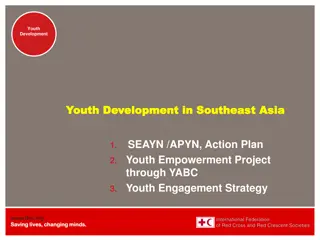The Use of Electronic Monitoring on Youth: Implications and Concerns in Milwaukee County
Electronic Monitoring (EM) is increasingly utilized on youth in Milwaukee County, sparking debates on its effectiveness and ethical implications. From rigorous rules to impacts on privacy, community alienation, and mental health, the practice raises concerns about its rehabilitative goals on young individuals. Research teams are exploring the use of EM through mixed methods to better understand its effects on youth involved in the legal system.
Download Presentation

Please find below an Image/Link to download the presentation.
The content on the website is provided AS IS for your information and personal use only. It may not be sold, licensed, or shared on other websites without obtaining consent from the author.If you encounter any issues during the download, it is possible that the publisher has removed the file from their server.
You are allowed to download the files provided on this website for personal or commercial use, subject to the condition that they are used lawfully. All files are the property of their respective owners.
The content on the website is provided AS IS for your information and personal use only. It may not be sold, licensed, or shared on other websites without obtaining consent from the author.
E N D
Presentation Transcript
The Use of Electronic Monitoring on Youth in Milwaukee County By Kathryn Storm
What is EM? Electronic Monitoring are device is placed on the ankle of an individual through which a third party is able to track their location 24/7. The bracelet cannot be removed and some have the capabilities to monitor heart rate, blood alcohol content, and serve as a communication device. Devices such as this are considered forms of E- carecreation. This is because the level of restriction put on the individual is heavy. While originally EM was a tool used for the adult system, in the early 2000s Milwaukee County began using it on youth. This is concerning because there is not evidence to support the use of this tool on youth and its effectiveness as a rehabilitative tool.
CURTOs Mixed Methods Research Team Qualitative Team Quantitative Team Conducts interviews with stakeholders Working through county provided data Developing Case Studies with youth Exploring risk assessment tools The YASI
Road Map to Electronic Monitoring There are several ways a youth can end up on EM when engaged in the juvenile legal system. 1) During their initial hearing the commissioner puts it on the youth as a pre-trial tool 2) A Judge can put the youth on EM 3) A Human Service Worker is given discretion by the judge to place youth on EM EM is a tool heavily influenced by discretion.
Rules and Restrictions of EM The guidelines youth need to adhere to while on EM are extremely rigorous. While damaging the bracelet and trying to remove it is typically considered the most serious violation, it is up to the system stakeholders to decide whether the violation is detention worthy or if it will be addressed in a conversation. Youth are under 24/7 surveillance and any movement needs to be preapproved at least 48 hours in advance. Some youth are on a One Rule Violation condition, meaning if they violate the terms of EM for any reason they will be sent to secure detention. This condition is at the discretion of the commissioners and Judges. When a youth breaks a rule on EM it is called a violation, but whether these impact the youths trajectory in the legal system is up to the discretion of the Human Service Worker and Judges.
The Impact of EM on Youth Lack of Privacy Alienation from their community Losing jobs, kicked off sports team Highly stigmatized Mental Health Ramifications Isolating, can compound on preexisting struggles with anxiety and depression Contradicts rehabilitative goals of the juvenile legal system.
EM Ramping Up While EM originally was used for serious juvenile offenders to make weekend visits home during their detention, it now is predominantly a pre-trial tool. There have been examples offered of arguments made that a youth being successful on EM is justification to keep the device on as well, showcasing a prioritization of surveillance as opposed to rehabilitation. Pushing back against EM in the courtroom is a difficult line to balance because of the fear that judges will default back to detention
The Future of EM Alternatives to detention increased as a result of the COVID 19 pandemic. However, currently there is no nation wide data about how many people are on EM and the growth of its use. Influential Works: Understanding E-Carceration by James Kilgore Virtual Shackles by Chaz Arnett Scholars such as James Kilgore, Chaz Arnett, and Katie Weisburd are taking up the task of expanding EM scholarship. No More Shackles, 10 Arguments against Pre- trial Electronic Monitoring by MediaJustice























